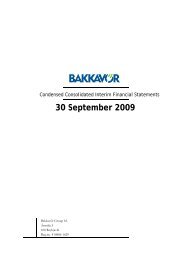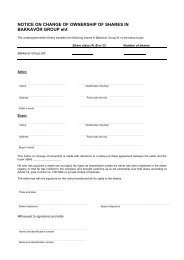Download our latest Annual Report - Bakkavor
Download our latest Annual Report - Bakkavor
Download our latest Annual Report - Bakkavor
Create successful ePaper yourself
Turn your PDF publications into a flip-book with our unique Google optimized e-Paper software.
BAKKAVOR ANNUAL REPORT AND ACCOUNTS 2012<br />
notes to the consolidated financial statements<br />
continued<br />
2<br />
SIGNIFICANT ACCOUNTING POLICIES CONTINUED<br />
Financial assets and financial liabilities continued<br />
Other financial liabilities<br />
Other financial liabilities, including borrowings, are initially measured at fair value, net of transaction costs. Other financial liabilities are subsequently<br />
measured at amortised cost using the effective interest method, with interest expense recognised on an effective yield basis.<br />
Effective interest method<br />
Income is recognised on an effective interest basis for debt instruments other than those financial liabilities designated as at FVTPL. The effective<br />
interest method is a method of calculating the amortised cost of a debt instrument and of allocating interest income over the relevant period.<br />
The effective interest rate is the rate that exactly discounts estimated future cash payments through the expected life of the debt instrument, or,<br />
where appropriate, a shorter period, to the net carrying amount on initial recognition.<br />
Financial assets and financial liabilities at FVTPL<br />
Financial assets and financial liabilities are classified as at FVTPL when the financial asset/liability is either held for trading or it is designated as<br />
at FVTPL.<br />
A financial asset/liability is classified as held for trading if:<br />
• It has been acquired/incurred principally for the purpose of selling/disposal in the near term; or<br />
• It is a part of a portfolio of identified financial instruments that the Group manages together and has a recent actual pattern of short-term<br />
profit-taking; or<br />
• It is a derivative that is not designated and effective as a hedging instrument.<br />
A financial asset/liability other than a financial asset/liability held for trading may be designated as at FVTPL upon initial recognition if:<br />
• Such designation eliminates or significantly reduces a measurement or recognition inconsistency that would otherwise arise; or<br />
• The financial asset/liability forms part of a group of financial assets or financial liabilities or both, which is managed and its performance is evaluated<br />
on a fair value basis, in accordance with the Group’s documented risk management or investment strategy, and information about the Group is<br />
provided internally on that basis; or<br />
• It forms part of a contract containing one or more embedded derivatives, and IAS 39 Financial Instruments: Recognition and Measurement permits<br />
the entire combined contract (asset or liability) to be designated as at FVTPL.<br />
Financial assets/liabilities at FVTPL are stated at fair value, with any resultant gain or loss recognised in the income statement. The net gain or loss<br />
recognised in the income statement incorporates any dividend or interest earned on the financial asset and interest paid on the financial liability. Fair<br />
value is determined in the manner described in note 29.<br />
Impairment of financial assets<br />
Financial assets, other than those at FVTPL, are assessed for indicators of impairment at each statement of financial position date. Financial assets<br />
are impaired where there is objective evidence that, as a result of one or more events that occurred after the initial recognition of the financial asset,<br />
the estimated future cash flows of the financial asset have been affected.<br />
Objective evidence of impairment could include:<br />
• significant financial difficulty of the issuer or counterparty; or<br />
• default or delinquency in interest or principal payments; or<br />
• it becoming probable that the borrower will enter bankruptcy or financial re-organisation.<br />
For certain categories of financial assets such as trade receivables, assets that are assessed not to be impaired individually are, in addition, assessed<br />
for impairment on a collective basis. Objective evidence of impairment for a portfolio of receivables could include the Group’s past experience of<br />
collecting payments, an increase in the number of delayed payments in the portfolio past the average credit period, as well as observable changes<br />
in national and local economic conditions that correlate with default on receivables. For financial assets carried at amortised cost, the amount of the<br />
impairment is the difference between the asset’s carrying amount and the present value of estimated future cash flows, discounted at the financial<br />
asset’s original effective interest rate.<br />
The carrying amount of the financial asset is reduced by the impairment loss directly for all financial assets with the exception of trade receivables,<br />
where the carrying amount is reduced through the use of an allowance account. When a trade receivable is considered uncollectible, it is written<br />
off against the allowance account. Subsequent recoveries of amounts previously written off are credited against the allowance account. Changes in<br />
the carrying amount of the allowance account are recognised in the income statement. If in a subsequent period, the amount of the impairment loss<br />
decreases and the decrease can be related objectively to an event occurring after the impairment was recognised, the previously recognised impairment<br />
loss is reversed through the income statement to the extent that the carrying amount of the asset at the date the impairment is reversed does not<br />
exceed what the amortised cost would have been had the impairment not been recognised.<br />
PAGE 65 VIEW THE FULL REPORT AT ANNUALREPORT12.BAKKAVOR.COM










